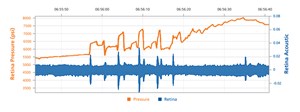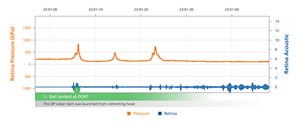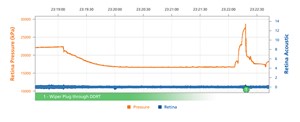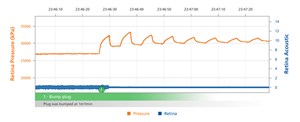New monitoring technology enables operators to verify perforations and troubleshoot more effectively using fewer resources
Closely watching pressure and pump charts to monitor downhole operations is a timeless tradition. These charts are one of the most effective tools that sit at the intersection of efficiency and cost. When uncertainty arises, however, the precise nature of an issue cannot always be found in a pressure or pump chart, and hours or days can often be wasted on trial-and-error methods to solve operational problems. Additional operational or downhole data can be gathered, using microseismic, tracers or cameras; but not all of these can be used concurrently with standard operations. Furthermore, they are generally too costly or time-consuming to use on every well.
ePLUS Retina technology. However, there is technology available that allows operators to acquire these data at a minimal cost. Packers Plus developed the ePLUS Retina monitoring system as a cost-effective method to verify downhole events and completion system operations, independently from other measurements, Fig. 1. Using Retina, operators can troubleshoot quickly and effectively with accurate information.
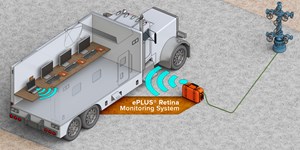
The monitoring system is an innovative technology that uses a proprietary array of sensors to collect and analyze signals from multiple locations on the well site. This portable system operates independently from conventional measurement equipment, without interfering in concurrent surface or downhole operations. The Retina user interface combines real-time measurements from two different types of sensors: acoustic and pressure. A sampling rate of 10,000 data points per second offers more detail and accuracy than standard data van readings, providing operators with real-time confirmation and confidence in making key decisions. A better understanding of downhole operations can improve a wide range of operations, saving valuable time and resources on site.
Historical perspective. Lost stages correlate directly to lost production and, ultimately, lost revenue. Similarly, shift sleeve malfunctions or ball failures during fracturing operations result in lower production and lower ultimate recovery. This was demonstrated in a U.S. Mid-continent study, showing that successful ball seat landings correlate to higher production.1
Specific downhole events during completion operations have been correlated to distinct pressure signatures, such as a ball landing on seat or a port sleeve shifting. However, many operations are not associated with pressure. Pressure signatures can be unclear because of low bottomhole pressure, varying pump rates, or low data acquisition rates, while other events are not detected using pressure—such as ball launches or perforation charge detonation. This results in an incomplete picture of completion operations. While Retina has been deployed in both onshore and offshore completions, there are a few specific cases that have proven to be valuable to operators:
- Verifying ball launches
- Verifying mill-out operations
- Improving safety.
Ball launch verification. A ball launch is a surface event that is not detected with pressure measurements. Automatic ball launchers are commonplace for multi-stage, ball-drop completions. While ball launchers are meticulously set up and verified multiple times, the ball launch event has no direct indicators—that is, the ball leaving the apparatus and moving down the wellhead cannot be verified. This event is only confirmed later with a pressure increase resulting from the ball landing on the seat.
Fluid can be wasted to flush the ball in cases where balls are frozen to the launcher (during winter operations, for example) or not injected properly into the high-rate fluid stream being pumped below.
Retina verifying the launch time allows the operator to adjust on the fly for balls that left the launcher early or late. If a ball leaves earlier than expected, the ball could hit the seat before the rate is lowered. Balls are launched at full frac rate and, typically, rate is lowered to 1.5 – 2m3 /minute when seating a ball. If a ball seats at frac rate, the event is typically unidentifiable.
A ball launch can be seen distinctly on Retina charts. By eliminating issues regarding surface events and providing verification of surface events with accurate, real-time information, operators can troubleshoot effectively and eliminate hours of trial-and-error problem solving.
Verifying millout operations. In post-stimulation operations, operators can confirm ball recovery during flowback or identify a milling motor stall or burnout. Motor stalls can occur, if fluid circulation is lost, if jets are plugged, or if the torque is too high. When multiple balls have been launched for one stage, mill-out can be a challenge. Operators can use Retina to verify that flowback and mill-out parameters are achieving the desired results.
Improving safety. Oil and gas extraction activities in the U.S. resulted in 28 fatalities between 2004 and 2014, due to fire or explosion (U.S. Bureau of Labor Statistics). The wellhead is a dangerous area, where these incidents can happen, due to high pressure, explosive potential, or sour gas. This area of the site is often called the red zone.
During plug-and-perf completions, real-time verification of charges detonating is valuable information. Perforation guns that do not detonate, as expected, are a major safety risk, particularly when they are brought to surface to be defused manually. Charges may fire unexpectedly, if there are problems with the wireline. In post-stimulation operations, confirming ball recovery and monitoring debris flowback is also valuable safety information. These confirmations reduce the need for personnel to enter the red zone and reduce the risk of accidents.
CASE STUDIES
Retina improves timing of stimulation operations in hybrid completion. Packers Plus provided live monitoring and event verification for a third-party 35-stage, ball-activated/plug-and-perf hybrid completion in the Permian basin. The ePLUS Retina monitoring system provided precise timing of completion events, enabling the calculation of exact fluid volumes to stimulate each stage. The system also saved time and resources when balls were not detected, due to a problem with the ball launcher.
The hybrid completion was restricted to daylight hours only, so the operator had to maximize efficiency to lower total costs as much as possible. The system combined cemented ball-activated sleeves, using degradable balls for the lower 25 stages, with plug-and-perf for the upper 10 stages. Due to daytime-only operations, there were concerns about maintaining pressure integrity, due to the last ball of the day degrading overnight. To account for this, the next morning, the same ball was launched and confirmed to land on seat. As this was happening, Retina confirmed the ball from the previous evening passing through the seat.
During one of the initial stages, Retina operators observed the ball launch, but did not detect it travelling through the wellhead nor landing on the seat. A second ball was launched, with the same result. Without wasting further balls or fluid, the launcher was taken apart, and both balls were found trapped at the valve that should have released them to the frac line. After this, all balls were launched manually.
For each stage, the ball was launched and observed moving through the wellhead. This allowed the operator to calculate precise fluid volumes and time the pumps to accurately land the ball on seat. Retina confirmed the ball landing on the seat about 20 minutes later, followed immediately by the port sleeve shift. The detection of a ball landing on seat followed by a sleeve shifting was an important confirmation that the stimulation was targeting the correct zone. On average, ball-activated stages took approximately one hour from ball loading to the end of stimulation.
Following the completion of the ball-activated stages, plug-and-perf operations began. Retina verified the plug setting and perforation guns firing, followed by the plug ball launch and seating for the next stage. On average, plug-and-perf stages without operational issues took approximately 3.5 hrs, from deploying wireline to the end of stimulation.
In total, the Retina monitoring system verified:
- 94% of all 35 ball launches
- 100% of all 25 port shifts
- 100% of all 10 plugs setting
- 100% of all 40 perforation detonations.
This independent confirmation service supplied the operator with an additional layer of information to effectively troubleshoot and improve operational efficiency.
Monitoring system improves certainty and safety for perforating and flowback. Packers Plus collaborated with a service contractor to monitor mill-out operations following a plug-and-perf stimulation in the Permian basin. Well service operations are usually unseen. In most hydraulic fracturing jobs, operators correlate events to known pressure signatures, confirming the occurrence of specific subsurface events. Some events are unrelated to pressure, such as during plug-and-perf operations. Confirming a perforation charge detonation is valuable for safety mitigation, since undetonated charges may fire unexpectedly. For mill-outs, operators use a variety of indicators to determine that the mill is functioning, such as pressure, weight on the drill bit, depth and reactive torque.
Before millout procedures began, Retina detected all detonations on all observed stages. During flowback and millout, the system confirmed when the mill was actively milling and indirectly verified that the fluid viscosity and circulation rate were sufficient to flush debris to the surface, without reliance on traditional indicators. In many mill-out operations, a worker continuously monitors the fluid returns to check for milled debris. This is done in the red zone, a high-pressure area near the wellhead. Using Retina, the timing of each full sweep of debris moving to surface was known, thereby minimizing personnel time in this hazardous area.
During stage 5 of a 16-stage completion in Texas, ball launch and seat indications were not seen by either the data van or Retina. Not wanting to spend time shutting down operations and taking the wellhead apart to confirm the ball launch, the operator proceeded to stimulate the well as if the ball had landed, Fig. 2. When the ball for stage 6 was launched, it dislodged the stage 5 ball that was still in the launcher. Both balls traveled down the wellbore, landing and shifting stage 5 and stage 6 just 45 secs apart. The two events for each stage were clearly captured by Retina.
From this information, it can be inferred that Stage 4 was stimulated twice, and stage 5 not at all. Moreover, the cost and revenue lost in one of 16 stages is significant. With estimated drilling and completions expenses of approximately $5 million, each stage costs $312,500. Potential revenue from production is also lost, and reserves in the field remain untapped. Moving forward, the operator trusted the Retina data, which prevented these issues on future wells.
Retina verifies sleeve shift and ball seal for stage isolation. Retina has been used to confirm ball seating and sleeve shifting events in a variety of ball-drop completion systems. During a third-party ball-drop completion, several actuation balls were verified to have extruded through the seat. In each instance, the failure was seen as an abrupt decrease in pressure, along with a Retina acoustic indication, Fig. 3. This form of dual verification is only possible, using the sensitive instrumentation specifically developed for Retina.

A ball failure results in a missed stage, and overall production is lost, if the failure is not identified and the stage is left untreated. Historically, operators have had to guess or spend time interpreting whether a lack of pressure was due to a sleeve not opening, a ball not seating, or a missing pressure signal. Using Retina, it is possible to verify any or all of these scenarios and take corrective action, removing guess work and eliminating costly delays during fracturing operations.
Retina monitors limited entry ball drop frac sleeves. Packers Plus QuickPORT IV ports allow an operator to stimulate multiple sleeves at a time with limited entry technique, as used in plug-and-perf applications. The sleeves have carbide nozzles that prevent erosion, providing even frac distribution for the full treatment. The sleeves are typically configured to stimulate between two and six ports at a time. An example of a cluster of five ports is shown in Fig. 4. Retina confirmed all five port opening events and confirmed that the ball remained on the final port, providing stage isolation.
QuickPORT IV Sleeves are used to stimulate completed wells, where plug-and-perf would be more costly (in cases where not enough wells are being stimulated on a pad to keep the crew continuously operating). Operators also use the sleeves at the toes of wells to lower the risk of operations and in cases where post-well drill-out is a challenge.
System monitors liner hanger setting and plug bump in Montney shale. Some Montney wells are constructed with intermediate casing to 90° and after drilling the horizontal section, a liner is cemented in place. Setting a liner hanger and cementing is an extremely critical part of the operation. The monitoring system can be used to ensure each part of the operation is going as planned. If an issue arises, Retina allows for a quick adjustment that can save operators time and cost.
Once the liner is on bottom, the first step is to launch a ball, which lands in the liner hanger drill-down running tool, Fig. 5. The ball releases the torque lock feature and is released to the bottom seat, allowing pressure to build, setting the packer slips. Further pressure releases indicate ball and cementing operations can begin. Once the cement has been pumped, the wiper plug is launched, Fig. 6.
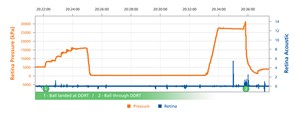
The wiper plug is pumped down the drill pipe until it reaches the liner hanger, Fig. 7. The drill pipe wiper lands in the casing wiper at the bottom of the running tool. Pressure increases and shears the pins, allowing the wipers to release, and they are then pumped to the toe of the well. The wiper plug is then seated in the landing sub, Fig. 8. Verification of each step is crucial, so changes can be made on-the-fly if challenges arise.
CONCLUSION
Stakes are high during on-site operations. Operators want as much information as possible to run a completion efficiently and troubleshoot problems effectively and immediately with minimal downtime. The goal of Retina is to foster an environment for confident decision-making to save time and reduce costs. The monitoring systems also offer benefits, in addition to visualizing well operations, including:
- Improving safety: By verifying perforation and mill-out events, workers have fewer reasons to be in the red zone.
- Increasing accuracy and lowering costs: Detecting events with exact timing allows operators to both troubleshoot more effectively, and optimize completions by using fewer resources.
- Reducing uncertainty: Independent confirmation lowers operational risk and gives operators the confidence to make decisions.
Packers Plus’ knowledgeable and experienced specialists have been dedicated to providing customized solutions to clients around the world for 20 years. The firm has a reputation as the premier ball-drop completion system provider, with 250,000 stages completed worldwide. The company recently expanded its offerings to include innovative technologies for a variety of applications and multiple segments of a well completion. These new products are designed to help producers improve operational efficiency, reduce risk and improve completion programs. Learn more about the company and its multi-stage completion system technology at packersplus.com.
REFERENCE
- Van Sickle, S., et al, “Economic and operational analysis of systematically deploying new technologies in two U.S. unconventional plays” SPE paper 176984, 2015.

- Digital transformation/Late-life optimization: Harnessing data-driven strategies for late-life optimization (March 2024)
- The reserves replacement dilemma: Can intelligent digital technologies fill the supply gap? (March 2024)
- What's new in production (February 2024)
- Digital tool kit enhances real-time decision-making to improve drilling efficiency and performance (February 2024)
- U.S. operators reduce activity as crude prices plunge (February 2024)
- U.S. producing gas wells increase despite low prices (February 2024)
- Applying ultra-deep LWD resistivity technology successfully in a SAGD operation (May 2019)
- Adoption of wireless intelligent completions advances (May 2019)
- Majors double down as takeaway crunch eases (April 2019)
- What’s new in well logging and formation evaluation (April 2019)
- Qualification of a 20,000-psi subsea BOP: A collaborative approach (February 2019)
- ConocoPhillips’ Greg Leveille sees rapid trajectory of technical advancement continuing (February 2019)


